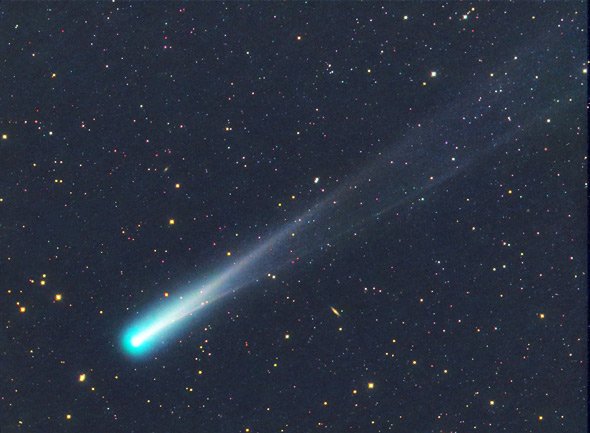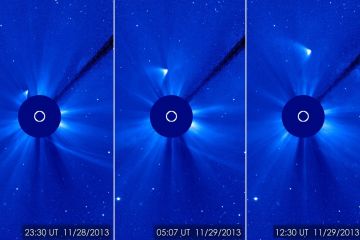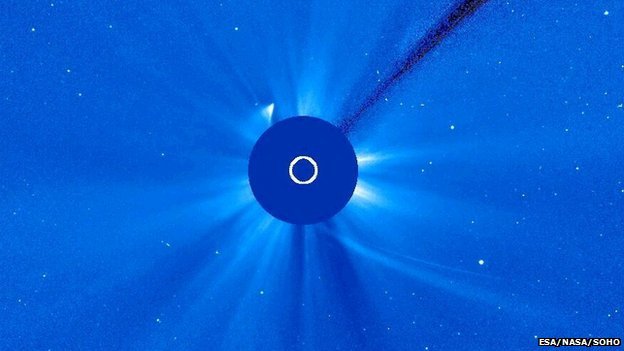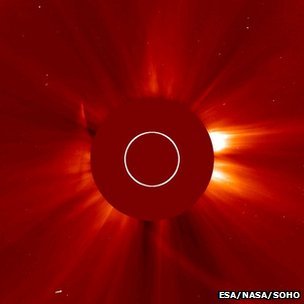Home Tags Posts tagged with "Comet"
Comet
Comet ISON was burned to death on its maiden voyage around the Sun, scientists say.
The comet, which excited astronomers and the media as it zipped within 730,000 miles of the sun on Thanksgiving Day, was pronounced dead at a scientific conference Tuesday.
Naval Research Lab astronomer Karl Battams, who headed the observing campaign for the comet, said ISON was stretched and pulled by the sun’s powerful gravity. It was also hit with solar radiation. And the icy snowball just fell apart.

Comet ISON was burned to death on its maiden voyage around the Sun
“At this point it seems like there is nothing left,” Karl Battams said at the American Geophysical Union conference in San Francisco.
“Sorry, everyone, Comet ISON is dead. But its memory will live on.”
Astronomers had hoped it would survive because some comets make it past close approaches with the sun. Last year, Comet Lovejoy did.
According to some specialists, Comet ISON appears to have survived a close encounter with the Sun that had threatened to vaporize it.
The remnant could now go on to be visible from Earth in December, but astronomers do not know how bright it might become.
Travelling at more than 200 miles per second, ISON passed 730,000 miles above the sun’s 6,000C surface on Thursday evening. This would have heated the comet to almost 3,000°C, enough to vaporize rock as well as ice.
The hope was that the comet would remain sufficiently bright to be visible with the unaided eye throughout December. However, as ISON sped towards the sun, it faded dramatically from view. This led some experts to assume it had disintegrated.
“I’m not seeing anything that emerged from behind the solar disc. That could be the nail in the coffin,” said astrophysicist Karl Battams, from the Naval Research Laboratory in Washington, during a live broadcast on NASA TV.
Yet, rumors of the comet’s demise may have been greatly exaggerated. Overnight, something following ISON’s orbit re-emerged on the opposite side of the sun. Now it is brightening as it plunges back into deep space.

Comet ISON appears to have survived a close encounter with the Sun that had threatened to vaporize it
“To all intents and purposes it looked like it had gone, and then amazingly this thing appears out the other side,” said Professor Tim O’Brien, associate director of the University of Manchester’s Jodrell Bank observatory.
“What we don’t know is whether the whole thing fell apart and whether the dust that was embedded within the ice is just basically in a big cloud and that is continuing to orbit,” he explained.
“The question is, is it just a cloud of dust … or is there still either one or more remnants of the nucleus.”
The nucleus, a huge lump of rock and ice, was several miles wide on its approach to the sun, and brightened as the sun heated it to create an atmosphere, or coma, of ice and dust which was blown away from the sun to form a tail.
But radiation pressure, extreme heat and gravitational forces could have ripped the comet apart.
If the remnant is a cloud of dust it will rapidly dissipate. If it is solid the sunlight will continue to vaporize its ice, creating a tail that may be visible from Earth.
[youtube AtPvSwBWPRY 650]
Some part of Comet ISON may have survived its encounter with the Sun, scientists say.
The giant ball of ice and dust was initially declared dead when it failed to re-emerge from behind the star with the expected brightness.
All that could be seen was a dull smudge in space telescope images – its nucleus and tail assumed destroyed.
But recent pictures have indicated a brightening of what may be a small fragment of the comet.
Astronomers admit to being surprised and delighted, but now caution that anything could happen in the coming hours and days.
This remnant of ISON could continue to brighten, or it could simply fizzle out altogether.

Some part of Comet ISON may have survived its encounter with the Sun
“We’ve been following this comet for a year now and all the way it has been surprising us and confusing us,” said astrophysicist Karl Battams, who operates the NASA-funded Sungrazing Comets Project.
The European Space Agency (ESA), too, which had been among the first organizations to call the death of ISON, has had to re-assess the situation. A small part of the nucleus may be intact, its experts say.
How much of the once 2 km-wide hunk of dirty ice could have survived is impossible to say.
Passing just 1.2 million km above the surface of the Sun would have severely disrupted ISON. Its ices would have vaporized rapidly in temperatures over 2,000C. And the immense gravity of the star would also have pulled and squeezed on the object as it tumbled end over end.
Karl Battams said: “We would like people to give us a couple of days, just to look at more images as they come from the spacecraft, and that will allow us to assess the brightness of the object that we’re seeing now, and how that brightness changes.
“That will give us an idea of maybe what the object is composed of and what it might do in the coming days and weeks.”
Whatever happens next, comets are going to be a big feature in the news over the next year.
[youtube h_mCNC31e9o 650]
Comet ISON was destroyed in its encounter with the Sun.
Telescopes saw the giant ball of ice and dust disappear behind the Sun, but only a dull streamer emerge.
Astronomers continued to search for the object, but it eventually became clear that the much vaunted “Comet of the Century” had gone out with a whimper.
Despite its great size, ISON was probably torn apart in the immense heat and tidal forces so close to the Sun.
The ESA’s experts on the SOHO Sun-watching satellite called the death of the comet at about 21:30 GMT.

Comet ISON was destroyed in its encounter with the Sun
“Our SOHO scientists have confirmed, Comet ISON is gone,” ESA’s twitter feed announced.
ISON had captivated skywatchers with its promise ever since it was discovery by Vitali Nevski and Artyom Novichonok in 2012.
A “fresh”, 2 km-wide object flung in towards the inner Solar System from its home far beyond the outer planet Neptune, it was hoped it might produce a brilliant tail that would arc across the night sky, perhaps for weeks.
And, as it got closer and closer to the Sun, its ices did indeed begin to vaporise, releasing dust that shimmered in a distinctive trailing stream.
But from early on, it was clear ISON was unlikely to be spectacular; it was just not brightening in the way experienced comet watchers had anticipated.
This led scientists to fear for its survival when it eventually grazed past the star at a distance of just 1.2 million km at 18:35 GMT on Thursday.
SOHO followed ISON as it began its sweep around the back of the Sun, but then failed to pick up a coherent object at the time it was supposed to re-emerge. A streak in the imagery was interpreted as the last fizzling of debris.
Other telescopes such as NASA’s Solar Dynamics Observatory could detect no clear sign of the comet’s nucleus, either.
Passing close to the Sun, ISON would have been subjected to temperatures over 2,000C. And the immense gravity of the star would also have pulled and squeezed on the object as it tumbled end over end.
All the evidence suggests ISON’s nucleus was torn apart in the close pass, in the same way that Comet Lovejoy – a previous hopeful in 2011 – was disrupted.




